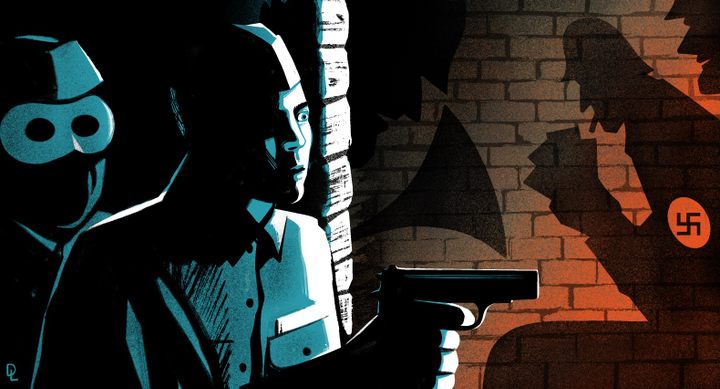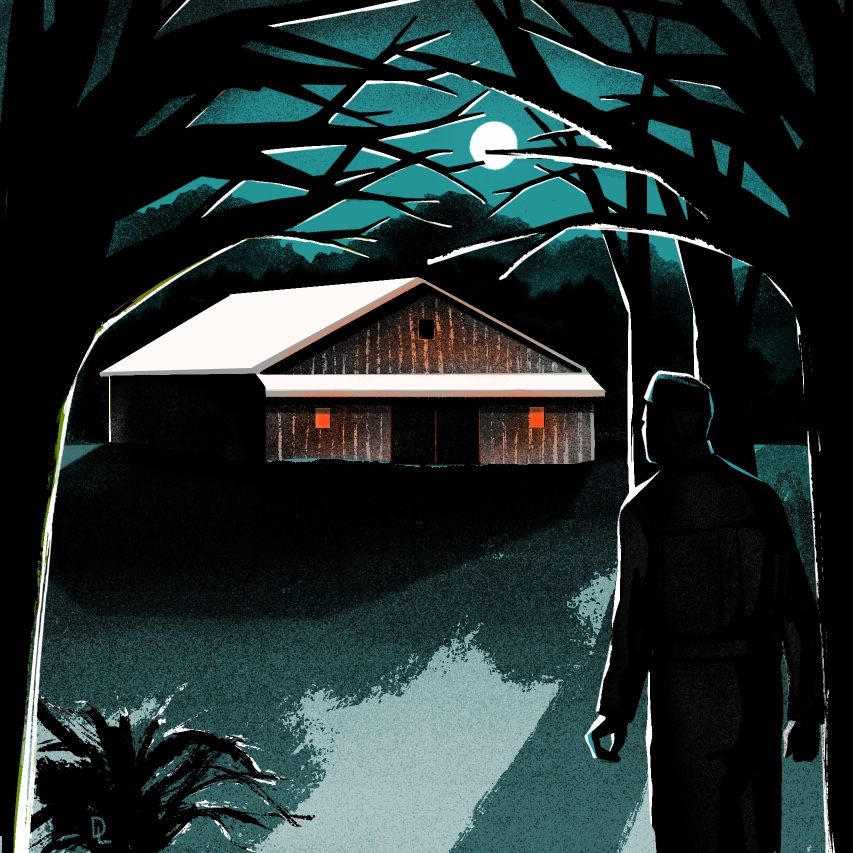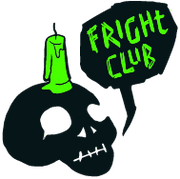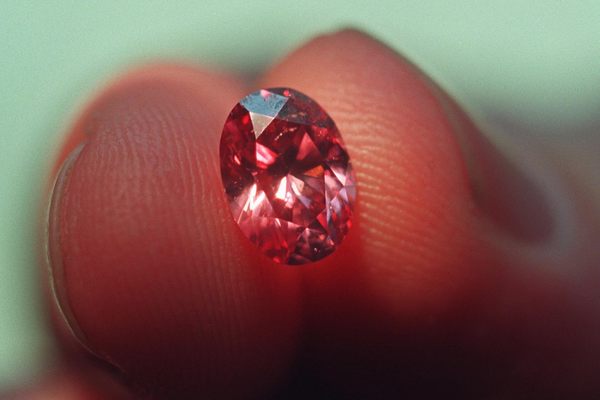
The Haunted Houses Designed to Scare Spooks
These WWII-era “houses of horrors” trained American spies for combat using cardboard Nazis.
The wooden building looked like something out of a child’s drawing: a squat rectangle topped by a pitched roof, with a darkened window on either side of the central door. It stood at the edge of a forest clearing, fringed by towering hardwood trees.
Herbert Brucker clutched a .45-caliber Colt automatic pistol in his hand as he entered the building one day in the fall of 1943. The tall, lean 21-year-old had two magazines—12 bullets. Behind him, just out of his sightline, a man in a mask followed.
Inside, it was pitch black, but from somewhere nearby came the sounds of a toast and the slap of cards being dealt, then the unmistakable cadence of German conversation. For a moment, Brucker might have thought he had caught the Nazi guards unaware. But as he turned a corner, one suddenly popped up.
Brucker had been trained to fire twice and keep moving. He must have hit his target and the five more that confronted him in the darkness, because he survived the “house of horrors”—one of the many colorful nicknames trainees gave the unusual shooting gallery featuring cardboard Nazis. On the western slope of Catoctin Mountain, 50 miles northwest of Baltimore, this “haunted house” tested their readiness to join the ranks of the Office of Strategic Services (OSS) and spy on the Axis forces in World War II.
“It was a nerve-wracking drill that most dreaded,” Brucker remembered in an interview with history office of the U.S. Army Special Operations Command. “I don’t know which was scarier—the spook house or Fairbairn.” William “Dangerous Dan” Fairbairn was the creator of this terrifying obstacle course—the precursor to the style of shooting houses that U.S. police and military often use to train today—and he was the masked man who followed his trainees through the trial, rating their performance. “But,” said Brucker, who parachuted into occupied France in 1944, “it later paid off for me.”

This was a different kind of war,” Alexis Albion, curator of special exhibits at the International Spy Museum in Washington, D.C., says of the WWII battlefields Brucker was training for. “This was guerrilla warfare, and the United States didn’t have the resources for it.”
“Wild” Bill Donovan, a decorated World War I veteran, lawyer, and politician with President Franklin D. Roosevelt’s ear, had a solution: the OSS, the country’s first centralized intelligence agency, which would train spies for daring missions behind enemy lines. The civilian-run organization, which was established by presidential order in June 1942 and is considered to be the predecessor of today’s Central Intelligence Agency, recruited “unconventional soldiers,” Albion says. Many were civilians who came from the ranks of the Ivy League and Hollywood; others were immigrants with coveted language skills.
These unconventional recruits needed unconventional training. For that, the OSS repurposed Civilian Conservation Corps buildings and summer camps on National Park Service land at Catoctin Mountain, now home to Camp David and Prince William Forest Park, adjacent to Marine Corps Base Quantico in Virginia. There the OSS trainees learned about communications technologies and codes and studied tactics of infiltration, espionage, and hand-to-hand combat.
The OSS is most commonly remembered for its gentleman—and woman—spies, such as baseball player Moe Berg and Julia Child, but espionage in the OSS wasn’t always subtle. “Donovan was all about drama,” says Nicholas Reynolds, an OSS historian who previously worked at the CIA Museum in McLean, Virginia. “He couldn’t decide whether he liked commandos or traditional spies better. But in his heart of hearts, it was commandos, manly men who could charge the German headquarters, kill some people, and get a few documents.”
To prepare for such missions, they faced Fairbairn’s “scare house”—yet another nickname bestowed by anxious trainees on what Fairbairn more prosaically called a “pistol house.”

The structure at Mount Catoctin was the most expensive built for the training camp—a $6,000 investment. (At least one other was built, in Prince William Forest.) And it was clearly a point of pride; Academy Award–winning director and OSS officer John Ford made a short training film inside. The floors of the 3,100-square-foot building were intentionally uneven, and though the hallways weren’t notably narrow, their twists and shadows made them feel claustrophobic. The realistically outfitted “Nazis” were operated by wires and positioned amid sandbags and soil backstops to catch the bullets. Lighting effects and the sound of gunfire accompanied their sudden appearance, and the haunting sounds of that poker game came from a hidden phonograph.
The idea of a pistol house was not wholly novel. Fairbairn had used them for training decades earlier in Shanghai, where he had been the commander of the Municipal Police riot squad. At the start of the war, he was recruited by the British Special Operations Executive—the model on which Donovan built the OSS—to teach what he called “gutter fighting,” or close combat skills. But his techniques were new to the American repertoire.
Fairbairn was blunt in his opinions and drilled his students on speed in everything. “If their first shot takes longer than a third of a second to fire, they will not be the one to tell the newspaper about it,” he reportedly said. “It is literally a matter of the quick and the dead—so they can take their choice.” It’s also no coincidence that the trainees were asked to navigate through the faux enemy territory without backup. Many would be sent on solo missions overseas.
Years later, OSS member Edgar Prichard recalled the training ordeal in a speech. He was awoken in the middle of the night and rushed to a darkened house for a “special mission.” He was told there were Nazi soldiers inside. “I wasn’t sure whether there really was a Nazi soldier there or not,” he said. “I kicked open the door with my gun at the ready.” Prichard successfully navigated the house, and later went undercover in North Africa, where he posed as a Pan American Airways employee while running the OSS communications center in Cairo. But his real-life exploits did not dim his memory of the final obstacle in the mystery house: a Nazi, seated in a chair, visible by the light of the cigarette in his hand. Prichard shot twice.
“If you didn’t shoot him, you failed the test,” said Prichard, but the pistol house was designed to test much more than the trainees’ firearm skills. It tested their mettle. “Under varying degrees of light, darkness, and shadows, plus the introduction of sound effects, moving objects, and various alarming surprises,” Fairbairn said, “an opportunity is afforded to test the moral fiber of the student and to develop his courage and capacity for self-control.”
Today, no Nazis lurk in the forest clearing where the OSS camp once stood. The headquarters building remains—it’s now an office for bucolic Camp Greentop—but Fairbairn’s pistol house has been demolished. There’s a barn near the site now and a pasture for horses. But the once-secret WWII history of the site remains a macabre draw for visitors, says Phillip Greenwalt, chief of interpretation and education at Catoctin Mountain Park. “You say the word ‘spy,’ and everyone goes ‘oooh,’” he says. “And this time of year, especially, people want to know about the ‘house of horrors.’”

























Follow us on Twitter to get the latest on the world's hidden wonders.
Like us on Facebook to get the latest on the world's hidden wonders.
Follow us on Twitter Like us on Facebook